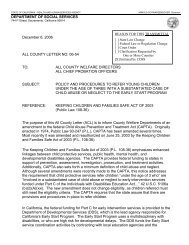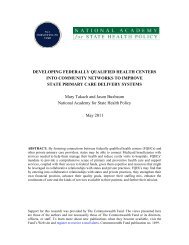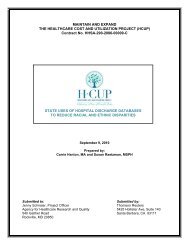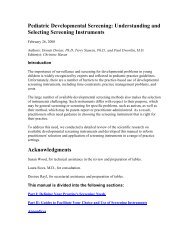Improving Care Coordination, Case Management, and Linkages to
Improving Care Coordination, Case Management, and Linkages to
Improving Care Coordination, Case Management, and Linkages to
Create successful ePaper yourself
Turn your PDF publications into a flip-book with our unique Google optimized e-Paper software.
10<br />
2. Inadequate service capacity for early childhood developmental <strong>and</strong> mental health services<br />
(i.e., insufficient provider capacity <strong>to</strong> provide services for identified problems). Across the country,<br />
the supply of developmental services for young children is limited, particularly intervention services<br />
for children with mild <strong>to</strong> moderate delays <strong>and</strong> early childhood mental health services. There<br />
are also long wait times at academic health <strong>and</strong> specialty centers for assessment for potentially<br />
serious delays <strong>and</strong> autism . 17 Children with Medicaid coverage or those who are uninsured may<br />
face additional barriers. Such limits in service capacity can make physicians reluctant <strong>to</strong> screen for<br />
developmental risks or delays, since a basic tenet in health care is <strong>to</strong> not screen unless the physician<br />
can treat the problem or is aware of the appropriate referral resources. 18<br />
3. Gaps between service delivery systems.<br />
Gaps between delivery service systems are generally<br />
driven by policy, program design, or categorical funding. For example, providers may be confused<br />
about when <strong>to</strong> refer an infant <strong>to</strong> a Title V program for Children with Special Health <strong>Care</strong> Needs<br />
(CSHCN), Neonatal Intensive <strong>Care</strong> Follow-up, or Part C Early Intervention. Varying definitions<br />
of “special health care needs”—across states <strong>and</strong> among programs—are a barrier. Some states<br />
include only a narrow range of chronic conditions in their Title V CSHCN definition <strong>and</strong> have a<br />
separate definition for those with special needs who are exempt from Medicaid managed care<br />
enrollment. In some areas of the country, child development centers or early intervention centers<br />
operated (<strong>and</strong> primarily financed) by education systems may be the primary referral resource, yet<br />
may not be connected with pediatric primary care providers. Part C Early Intervention programs<br />
more often link <strong>to</strong> <strong>and</strong> provide physical, occupational, <strong>and</strong> speech-language-hearing therapies<br />
than mental health or medical services. Even among children referred for evaluation <strong>and</strong> found eligible<br />
in a service system such as Part C or children’s mental health, communication with pediatric<br />
primary care providers may be limited or ineffective.<br />
4. Insufficient payment/financing for care coordination/case management (CC/CM) . Although<br />
many pediatric primary care providers want <strong>to</strong> be a medical home for their patients, the cost of<br />
care coordination <strong>and</strong> other supports delivered in pediatric practice settings is substantial <strong>and</strong><br />
often uncovered by payers. 19 Having staff assigned <strong>to</strong> provide care coordination in the community<br />
(e.g., based in local health departments) also is costly <strong>and</strong> not routinely covered by health plans.<br />
Medicaid financing for case management has never been clearly defined <strong>and</strong> has become more<br />
complex following changes <strong>to</strong> law in the Deficit Reduction Act of 2005 (DRA). The definition<br />
of CC/CM varies across programs. Partitioned funding makes it possible for one family <strong>to</strong> have<br />
multiple care coordina<strong>to</strong>rs/case managers without effective coordination or a family-centered approach.<br />
Where states have adopted approaches using case managers or care coordina<strong>to</strong>rs focused<br />
on pediatric care, there may be only one per county.<br />
Different practice styles <strong>and</strong> cus<strong>to</strong>ms<br />
5. . Variations in professional practice are another challenge.<br />
Differences in practice cultures are important barriers at the community level. For example, both<br />
health care <strong>and</strong> early care <strong>and</strong> education providers play a central role in promoting child development<br />
but perceive their role <strong>and</strong> engage with families differently. Early care <strong>and</strong> education providers<br />
tend <strong>to</strong> think in terms of assessment (through observation) <strong>and</strong> intervention (through education)<br />
or referral, while health care providers tend <strong>to</strong> think in terms of identification, diagnosis <strong>and</strong><br />
referral <strong>and</strong>/or consultation. Similarly, while many public health <strong>and</strong> human services organizations<br />
expect staff <strong>to</strong> work in teams or in interagency meetings, few health providers have the time or<br />
inclination <strong>to</strong> work this way. In addition, physicians are accus<strong>to</strong>med <strong>to</strong> getting written feedback<br />
when they refer <strong>to</strong> or seek consultation from other physicians (i.e., a letter detailing the findings<br />
<strong>Improving</strong> <strong>Care</strong> <strong>Coordination</strong>, <strong>Case</strong> <strong>Management</strong>, <strong>and</strong> <strong>Linkages</strong> <strong>to</strong> Service for Young Children: Opportunities for States<br />
National Academy for State Health Policy
















